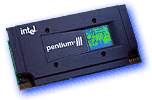|









My URL: http://welcome.to/lokeang

| |
|
 |
Product
Description
The Intel® Pentium® III
processor, Intel’s most advanced and powerful processor for desktop
PCs, integrates the best attributes of the P6 microarchitecture
processors—Dynamic Execution performance, a multi-transaction system
bus, and Intel® MMX™ media enhancement technology. In addition, the
Pentium III processor offers
Internet Streaming SIMD Extensions, 70 new instructions enabling
advanced imaging, 3D, streaming audio and video, and speech recognition
applications. With the power for the next generation of the Internet,
Pentium III processors are targeted
for professionals, avid PC users, PC gamers, or
enthusiast/professional/performance users. The Pentium III
processor also meets the needs of entry-level to mid-range servers and
workstations.
 |
|
Introduction
The Intel Pentium III processor
delivers excellent performance for all PC software and is fully
compatible with existing Intel® Architecture-based software. The
Pentium III processor at 500MHz and
450MHz extends processing power further by offering performance headroom
for business media, communication and Internet capabilities. Software
designed for the Pentium III
processor unleashes the full multimedia capabilities of the processor
including full-screen, full-motion video, realistic graphics, and an
enhanced, exciting Internet experience. Systems based on Pentium III
processors also include the latest features to simplify system
management and lower the total cost of ownership for large and small
business environments. The Pentium III
processor offers great performance for today’s and tomorrow’s
applications as well as quality, reliability and compatibility from the
world’s leading microprocessor company.
The Intel Pentium III processor
family includes 500MHz and 450MHz versions for desktops and entry-level
servers and workstations. All are binary compatible with previous
generation Intel Architecture processors. The 0.25 micron manufacturing
process enables these CPUs to include over 9.5 million
transistors—resulting in more processing power in less space. The
processor core is packaged in the Single Edge Contact Cartridge 2
(S.E.C.C.2.) or the Single Edge Contact Cartridge (S.E.C.C.) enabling
ease of design and flexible motherboard architecture.
The Pentium III processor
family’s significant performance improvement over previous Intel
Architecture processors is based on the seamless combination of the P6
microarchitecture, Internet Streaming SIMD Extensions, Intel MMX media
enhancement technology, and a processor serial number. The result is
higher software performance plus headroom for applications that take
advantage of the Pentium III
processor.
Product
Highlights
 | Available in 500MHz and 450MHz speeds.
 | Utilizes Intel’s 0.25 micron manufacturing process for increased
processor core frequencies and reduced power consumption.
 | Includes Internet Streaming SIMD Extensions, 70 new instructions
enabling advanced imaging, 3D, streaming audio and video, and speech
recognition applications, as well as Intel MMX media enhancement
technology.
 | The Pentium III processor at
500MHz delivers up to 93% more 3D processing performance (as
measured by 3D WinBench* 99—3D Lighting and Transformation test)
and 42% more multimedia performance (as measured by MultimediaMark*
99) than the 450MHz Pentium® II processor.
 | Dual Independent Bus (DIB) architecture increases bandwidth and
performance over single-bus processors.
 | The Pentium III processor
utilizes the Intel® 440BX AGPset.
 | Includes a processor serial number, the first of Intel’s planned
building blocks for PC security.
 | 32K (16K/16K) non-blocking, level-one cache and 512K unified,
non-blocking, level-two cache provide fast access to heavily used
data.
 | The Pentium III processor
supports memory cacheability for up to 4GB of addressable memory
space.
 | Enables scalable systems to be expanded to two processors and 64GB
of physical memory. |
| | | | | | | | |
P6
Microarchitecture Dynamic Execution Technology:
 | Multiple branch prediction: Predicts program execution through
several branches, thereby accelerating the flow of work to the
processor.
 | Dataflow analysis: Creates an optimized, reordered schedule of
instructions by analyzing data dependencies between instructions.
 | Speculative execution: Carries out instructions speculatively, and
based on this optimized schedule, ensures that the processor’s
superscalar execution units remain busy, thereby boosting overall
performance. |
| |
Internet
Streaming SIMD Extensions:
The Internet Streaming SIMD Extensions consist of 70 new instructions
and includes single instruction, multiple data for floating point,
additional SIMD-integer and cacheability control instructions. Some of
the technologies that benefit from the Internet Streaming SIMD
Extensions include advanced imaging, 3D, streaming audio and video, and
speech recognition applications. Specifically:
 | Higher resolution and higher-quality images can be viewed and
manipulated than was previously possible on consumer PCs.
 | High-quality audio, MPEG2 video and simultaneous MPEG2 encoding
and decoding.
 | Reduced CPU utilization for speech recognition, as well as higher
accuracy and faster response times. |
| |
Intel®
MMX™ Media Enhancement Technology:
Intel MMX technology is designed as a set of 57 basic,
general-purpose integer instructions and four data types that are easily
applied to the needs of a wide diversity of multimedia and
communications applications. Highlights of the technology include:
 | Single Instruction, Multiple Data (SIMD) technique.
 | Eight 64-bit wide Intel MMX technology registers. |
|
Intel®
Processor Serial Number:
The processor serial number, the first of Intel’s planned building
blocks for PC security, serves as an electronic serial number for the
processor and, by extension, its system or user, enabling the
system/user to be identified by networks and applications. The processor
serial number will be used in applications that benefit from stronger
forms of system and user identification, such as the following:
 | Applications using security capabilities: Managed access to new
Internet content and services; electronic document exchange.
 | Manageability applications: Asset management; remote system load
and configuration.
 | Information management applications: Help desk and error
reporting; data backup protection. |
| |
Other
significant features of the Pentium® III
processor include:
 | S.E.C.C.2. packaging, developed by Intel, enables high-volume
availability, improved handling protection, and a common form factor
for future high-performance processors.
 | High-performance Dual Independent Bus (DIB) architecture (system
bus and cache bus) for high bandwidth, performance and scalability
with future system technologies.
 | The system bus supports multiple outstanding transactions to
increase bandwidth availability. It also provides "glueless"
support for up to two processors. This enables low-cost, two-way
symmetric multiprocessing, providing a significant performance boost
for multitasking operating systems and multithreaded applications.
 | A 512K unified, non-blocking, level-two (L2) cache improves
performance by reducing the average memory access time and by
providing fast access to recently used instructions and data.
Performance is enhanced through a dedicated 64-bit cache bus. The
speed of the L2 cache scales with the processor core frequency. This
processor also incorporates separate 16K level-one caches, one for
instructions and one for data.
 | Both the Pentium III
processors 500MHz and 450MHz support memory cacheability for up to
4GB of addressable memory space.
 | Available with Error Correction Code (ECC) functionality on the
level-two cache bus for applications where data intensity and
reliability are essential.
 | A pipelined Floating-Point Unit (FPU) for supporting the 32-bit
and 64-bit formats specified in IEEE standard 754 as well as an
80-bit format.
 | Parity-protected address/request and response system bus signals
with a retry mechanism for high data integrity and reliability. |
| | | | | | |
The
Pentium III processor also includes
several features used for testing and performance monitoring:
 | Built-in Self Test (BIST) provides single stuck-at fault coverage
of the microcode and large logic arrays, as well as testing of the
instruction cache, data cache, Translation Lookaside Buffers (TLBs),
and ROMs.
 | IEEE 1149.1 Standard Test Access Port and Boundary Scan mechanism
enables testing of the Pentium III
processor and system connections through a standard interface.
 | Internal performance counters for performance monitoring and event
counting.
 | Incorporates an on-die diode that can be used to monitor the die
temperature. A thermal sensor located on the motherboard can monitor
the die temperature of the Pentium III
processor for thermal management purposes. |
| | |
The Pentium III
processor may contain design defects or errors known as errata. Current
characterized errata are available upon request.
Sources for performance data: Pentium III
Processor Performance Brief, System configuration: Intel® SE440-BX2
motherboard; 128MB SDRAM; Adaptec* AHA294OUW2W SCSI/PCI Hard Disk
Controller/Bus; Seagate Cheetah* ST391021,W; Diamond Multimedia Viper*
V550 AGP with 16MB SGRAM; Windows* 98 – build 1998; Toshiba* XM-6201B
SCSI CD-ROM Drive; Diamond MonsterSound* M80 PCI
|
|

![]()
![]()
![]()
![]()
![]()
![]()
![]()
![]()
![]()


